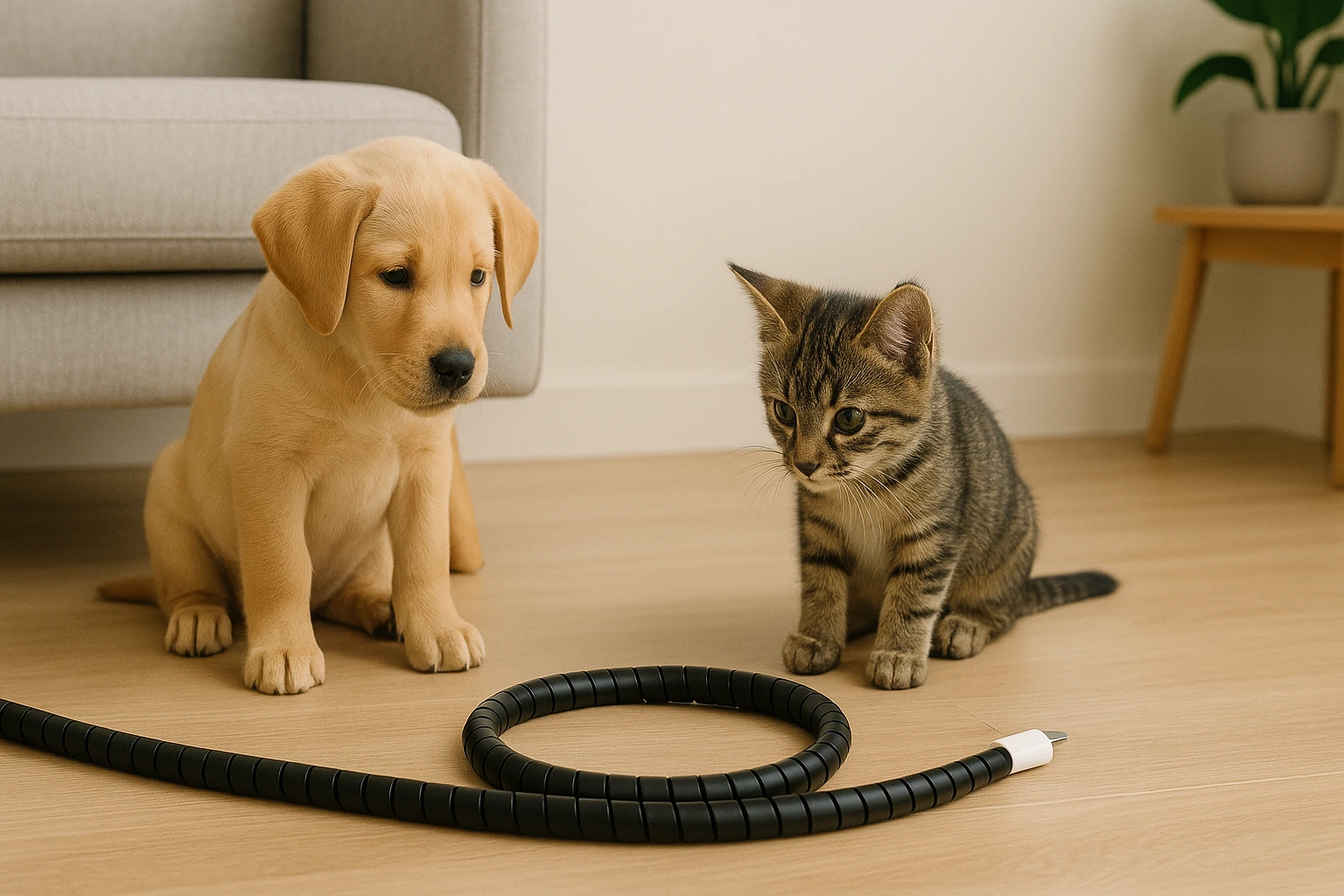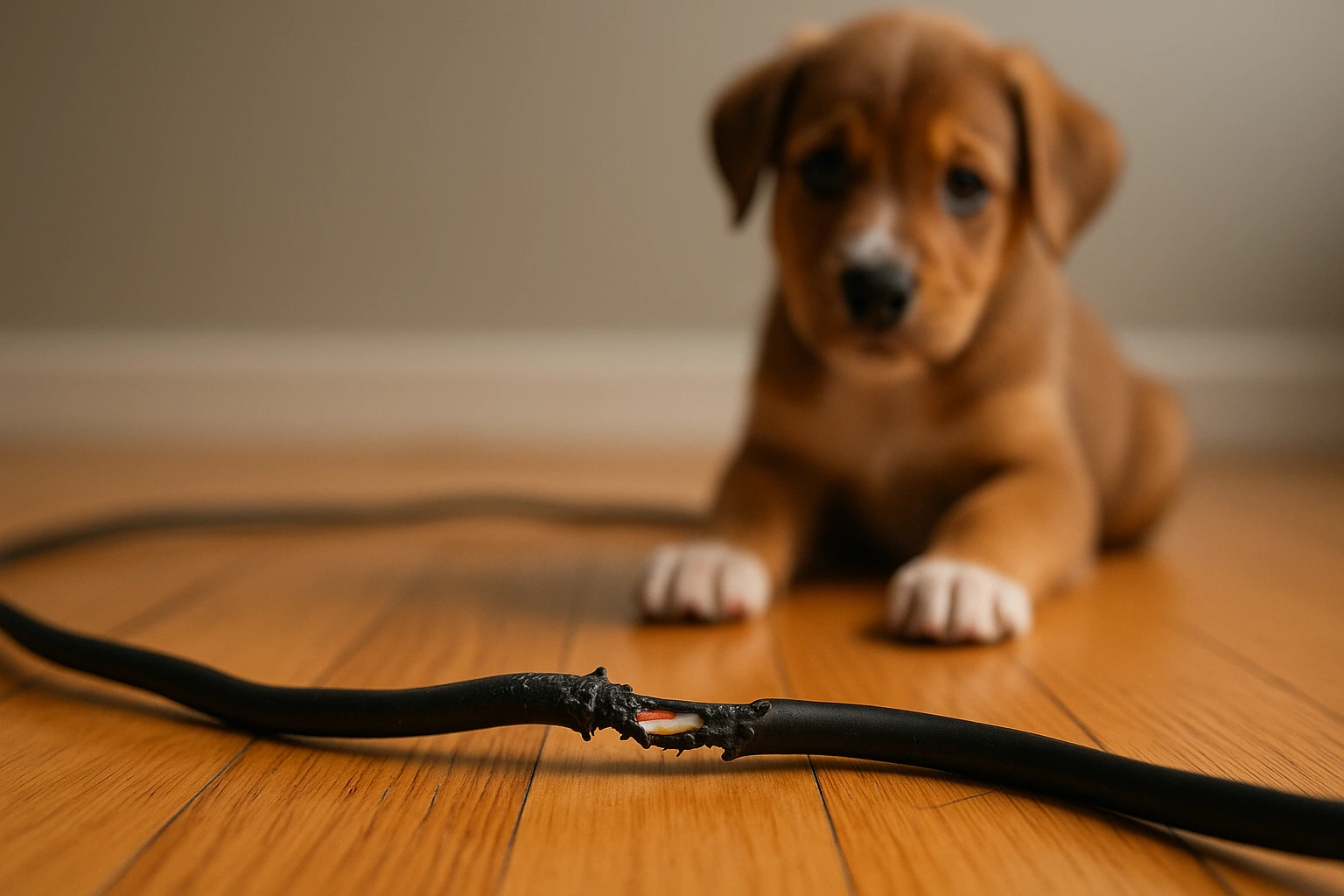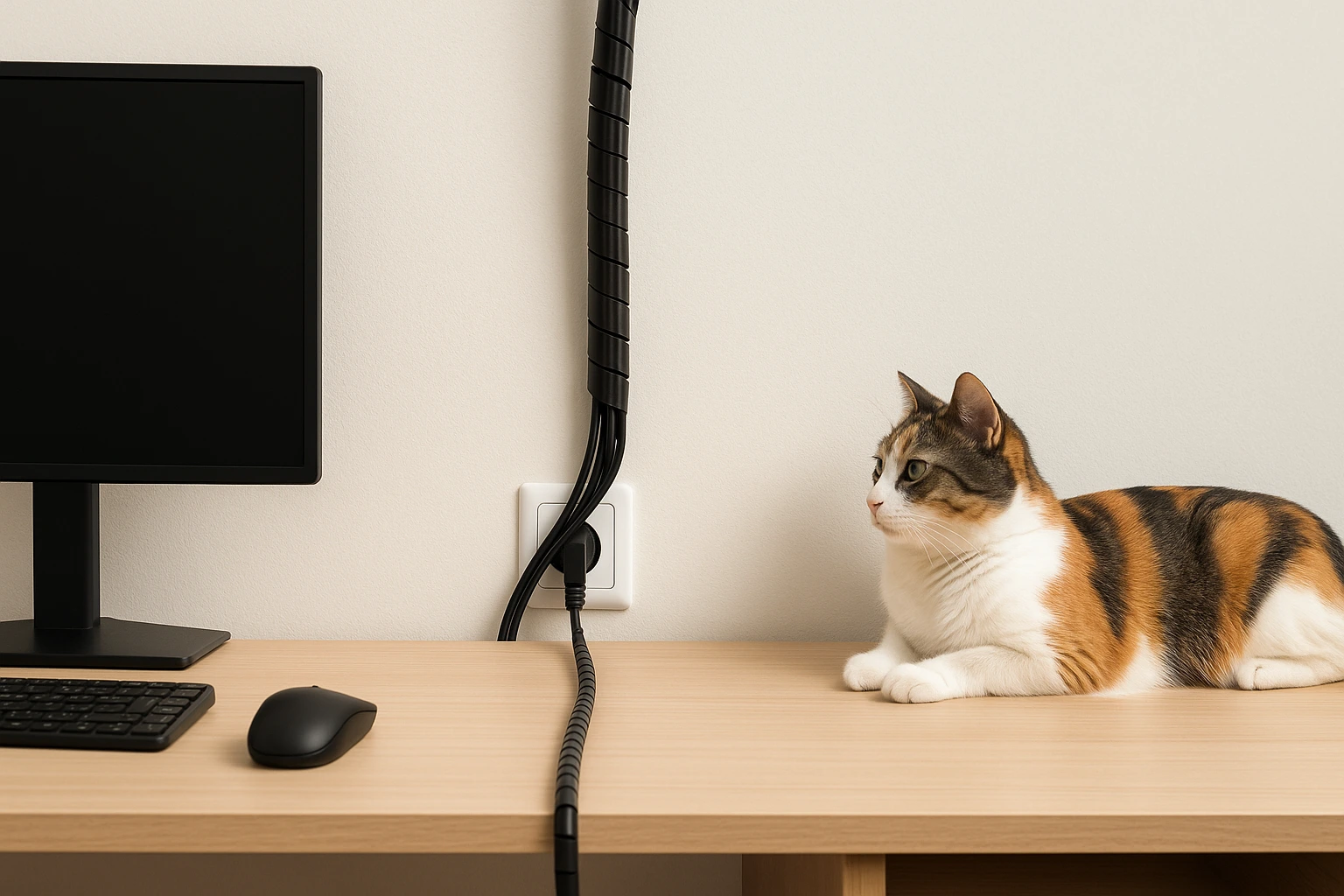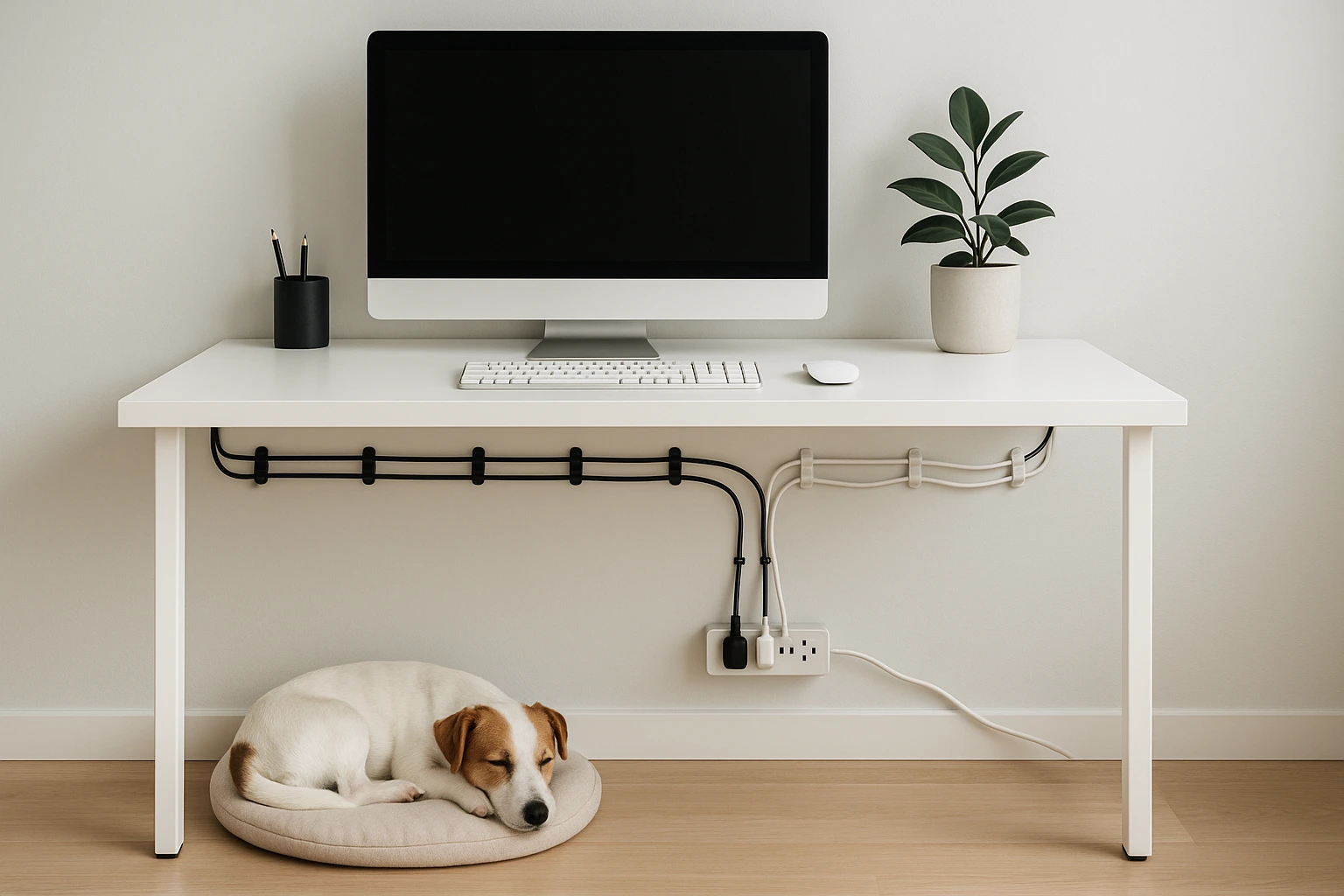
Got a curious kitten, teething puppy, or a cord-chomping gremlin in the house? Chewed cables can mean shocks, burns, even fires—but you don’t need pricey gear to fix it. Below are three quick fixes under $10 you can build in minutes—each one boosts pet cable safety on a budget. They’re part of our DIY pet projects—see our DIY pet cord protector guide for more options.
Find Your Best Protector!This page contains paid/affiliate links. As an Amazon Associate we earn from qualifying purchases, and we may earn commissions from other partners—at no extra cost to you. Links marked with ‘#ad’ are affiliate links, meaning we may earn a commission at no extra cost to you. Learn more.
Table of Contents
- Key Takeaways for Pet Cable Safety
- Why a DIY Cord Cover Matters
- Understanding Your Pet’s Chewing Habits
- Essential Safety Tips for Cord Covers
- Three Cord-Protector Fixes Under $10
- More Ways to Keep Cables Pet-Safe
- Choose Your Best Cord Cover
- Maintaining Your Cord Cover
- Frequently Asked Questions
- Final Thoughts: Safer Cables at Home
Key Takeaways for Pet Cable Safety
- Danger alert: A chewed cord can mean shocks, burns, or even a house fire—another reason pet cable safety matters.
- Save on fixes: Protect cords with simple household items or $10-and-under tools.
- Three quick DIYs: Try spiral wrap, PVC, or split-loom conduit—sturdy, cheap, and easy to fit.
- Safety first: Always unplug first. Damaged power cords are far riskier than data cables.
- Round it out: Pair DIY pet cord protectors with cord tidying, training, and chew-toy options.
Why a DIY Pet Cord Protector Matters
It’s natural for pets, especially puppies and kittens, to explore with their mouths. However, this behavior can turn deadly when electrical cords are involved. For instance, a single chew can puncture insulation, exposing live wires and leading to:
- Electric shock: A single bite can deliver a dangerous jolt and cause mouth burns or worse.
- Burns: Exposed wire can scorch mouths or paws—and those injuries aren’t always obvious.
- House fires: Frayed cords can overheat or spark and put the whole home at risk.
“Spiral wraps add a tough outer layer that can make cords less tempting for pets to chew.”
It also helps to know which cords need the most protection:
- Power cords (e.g., lamps, laptop chargers): Higher voltage—treat these as top priority.
- Data cords (e.g., USB, ethernet): Lower risk than power, but chewing still kills cables and can create trip hazards.
Consequently, using a pet cord cover is essential to keep all cords safe from curious pets. For more budget-friendly ways to make your home pet-safe, check out our guide on affordable home decorating.

Understanding Your Pet’s Chewing Habits
Why do pets go for cords? Pinning down the “why” makes it easier to choose the right sleeve and training plan. For example, my cat gnawed my phone charger after a long, lonely afternoon—pure boredom. Keep pet cable safety in mind as you read the list below:
- Dogs: Puppies chew during teething, and bored adult dogs might, too. I use tough protectors like PVC for my strong-jawed pup. PVC helps dog-proof cords that get the most action.
- Cats: Kittens explore by nibbling, and cats love dangling cords. Spiral wraps are great for their flexible cables—they help cat-proof cables near desks.
- Rabbits: Their powerful teeth chew constantly, so I rely on rigid PVC pipes to hold up against their gnawing.
Essential Safety Tips for Cord Covers
Before you start any DIY cable sleeve project, here’s how I keep safety first:
- Unplug Cords: I make sure to unplug cords completely—it’s a simple step to keep shocks at bay.
- Inspect for Damage: I check every cord for frays or exposed wires. If I spot damage, I replace the cord right away—no DIY cord cover can fix that.
- Keep Cords Out of Reach: I tuck cords behind furniture or up high to keep them away from curious paws.
- Supervise Pets: I keep an eye on my pet with new protectors, since nothing’s completely chew-proof.
- Use Bitter Spray (on the protector only): Lightly spritz the installed protector (not plugs, outlets, or power bricks) and let it dry fully before re-plugging. Natural anti-chew sprays are widely available.
- Don’t enclose power bricks/adapters: They need open air to stay cool.
- Keep plugs and vents uncovered: Never tape or sleeve over plug ends.
- Don’t run cords under rugs or pinch them: Heat + abrasion risk.
- Use GFCI outlets near water/damp zones: Extra protection where pets roam.
If your pet chews a live cord or shows signs like mouth burns, drooling, coughing, or trouble breathing, contact your veterinarian promptly. The AVMA notes that chewing plugged-in cords can cause burns or electrocution; use covers and block access. For damaged wiring or outlets, consult a qualified electrician.
Three Cord-Protector Fixes Under $10
Here are three cheap and easy pet cord cover ideas to keep your cords safe. Plus, I’ve added a handy comparison table for quick reference. If you’re looking to add some flair to your pet’s gear, try making cute dog collar accessories on a budget.
| Method | Materials | Cost | Best For | Durability |
|---|---|---|---|---|
| Spiral Cable Wrap | Spiral wrap, scissors | $5–$8 | Light to medium chewers, flexible cords | Moderate |
| PVC Pipe | PVC pipe, cutter/hacksaw, tape | $2–$10 | Super chewers, power cords | High |
| Cardboard Tube | Paper towel rolls, duct tape, scissors | ~$3 | Light chewers, data cords | Low |
Fix 1: Spiral Cable Wrap (DIY Cord Cover)
Spiral cable wrap is flexible, renter-friendly, and great for bundling. It’s my go-to for light and medium chewers—my curious kitty included. This cable sleeve keeps cords tidy and less tempting.
Materials Needed
- Spiral Cable Wrap: A 10-foot spiral cable wrap costs $5–$8 at hardware stores or on Amazon.
- Scissors or Utility Knife: Use what you have, or borrow one.
How to Protect Cords from Pets: Steps
- Unplug the cord(s) completely.
- Gather multiple cords if bundling (e.g., behind a TV).
- Feed cords into the spiral wrap’s slot, twisting it around as you go.
- Cut the wrap to size with scissors or a utility knife.
- Plug back in and monitor your pet’s reaction.
Pros and Cons
- Pros: Easy to install, flexible, reusable, renter-friendly, cost-effective.
- Cons: Not fully chew-proof for super chewers; may still attract determined biters.
Budget alternative: Split-loom conduit (corrugated, pre-slit) often costs under $8 for several feet and snaps over cords quickly—stronger than cardboard, more flexible than PVC.

Fix 2: PVC Pipe (Rigid Cover)
For heavy-duty protection, especially for power cords or super chewers like rabbits, PVC pipes create a solid barrier.
Materials Needed
- Small PVC Pipe (1/2 or 3/4 inch): A 2–3 foot section costs $2–$5.
- PVC Cutter or Hacksaw: $5–$10. Cut carefully and de-burr/sand edges. Do not use scissors.
- Duct Tape: Likely already owned (~$3–$6).
How-To Steps
- Unplug the cord(s).
- Measure and cut the PVC to the cord’s length.
- Carefully cut a lengthwise slit in the pipe with a utility knife or saw.
- Insert the cord into the slit.
- Secure the pipe to a wall or floor with tape if needed.
Pros and Cons
- Pros: Very tough—ideal for super chewers, cost-effective, long-lasting. This solution keeps high-risk cords safer with a durable barrier (still not chew-proof).
- Cons: Less flexible, requires more effort, not renter-friendly if secured permanently.
Fix 3: Cardboard Tubes (Temporary Data-Cable Sleeve)
This nearly free fix is great for light chewers or temporary solutions, especially for data cords.
Materials Needed
- Paper Towel/Toilet Paper Rolls: Free from household use.
- Duct Tape: ~$3–$6.
- Scissors: Use what you have.
How-To Steps
- Unplug the cord(s).
- Cut a slit down each tube for easier insertion.
- Feed the cord through the tube(s).
- Secure tubes with duct tape, wrapping fully for extra durability.
- Plug back in and monitor your pet.
Pros and Cons
- Pros: Nearly free, quick, renter-friendly, good for light chewers.
- Cons: Not durable, temporary, less stylish.
“For a curious nibbler, this cardboard trick is a fast, cost-free pet cable sleeve.”
More Ways to Keep Cables Pet-Safe
Besides a cable sleeve, try these tips for pet-proofing cords to keep cables safe. For example, keeping your home clean can also deter pets from chewing by reducing clutter—learn more in our guide to cleaning on a budget. If you’re traveling with your pet, consider building a simple pet barrier for your car to keep them safe on the road.

Choose Your Best Cord Cover
Maintaining Your Cord Cover
After installing your sleeve, regular maintenance ensures ongoing safety. Check weekly for:
- Chew Marks: New marks indicate your pet is still trying; consider a stronger protector.
- Wear and Tear: Replace damaged protectors immediately.
- Loose Fittings: Ensure wrappers or pipes remain secure.
Moreover, clean dust and pet hair from cords to reduce fire risks. As your pet ages, reassess their chewing habits, as a teething puppy’s needs differ from an adult dog’s. For more ways to save while raising pets, explore our tips for budget-friendly pet and kid care.
Frequently Asked Questions
Final Thoughts: Keep Cables Pet-Safe
Protecting cords with a DIY cord protector for pets safeguards your pet and home from serious risks. By combining these affordable solutions with cord management and training, you’ll keep cables pet-safe and minimize risks like shocks or fires. Which option will you try first? To explore more budget-friendly pet projects, check out our comprehensive complete pet DIY guide.
Safety Disclaimer: This information is educational and not a substitute for professional advice. Always unplug cords before installation; never cover plugs, outlets, or power bricks. Replace any damaged cords—do not attempt repairs with sleeves or tape. If your pet may have been electrocuted or shows concerning symptoms, contact a licensed veterinarian. For home wiring concerns, consult a qualified electrician.